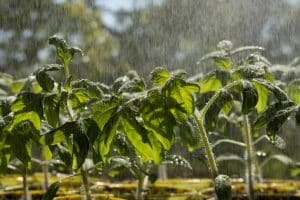Blueberries 101
by Rob Sproule
With it’s recent rockstar, superfood status, it’s easy to see why so many people are asking about how to grow blueberries. When asked, I’m used to getting a double-take when I tell them how many varieties will grow this far north.
Most of the blueberry (Vaccinum) family hail from North America, where First Nations peoples have been enjoying them for centuries. Samuel de Champlain observed First Nations harvesting blueberries near Lake Huron in 1615. The berries were dried, beaten into a pulp and combined with cornmeal, honey, and water to make a pudding.
Long before it was superfood, humble blueberries were used to treat coughs anddas relaxants during childbirth. Today we know they’re full of vitamin C, help lower blood pressure, and may inhibit the growth of breast cancer cells, among a host of other benefits.
The Basics
Although they’ve only become a commercial crop in the past century, blueberries have caught on quickly with dozens of hybrids available. Irresistible fruit aside, they boast a gorgeous fall foliage.
With the right soil (see below), blueberries are easy and well worth the blue fingers. They attract very few bugs, are easy to prune, and don’t shred you with thorns like raspberries or blackberries do.
They’ve considered self-pollinating, but having more than one plant will go a long way to increase your yield. As tempting as it is, pinch off all flowers the first year so it can’t bear fruit. It needs to develop its root system first before it boast proper yields.
They like well-drained soil and staying consistently moist. A few inches of wood mulch under their drip line will keep their shallow roots from parching. Because their roots are so shallow, avoid digging next to them.
Don’t prune them for the first 2 years while they establish. Patience is a virtue with blueberries; they’ll often live 100 years! After 2 years, trim off 1-3 of the oldest shoots per year.
Your yield will take a while to go from “a nibble” to “just enough to graze on” to “pies for everybody!” It will start to yield at year 2 but will take a few more to reach its bountiful maturity, at which point you’ll have blue lips every time you visit the garden.
Acid Lovers
Blueberrys’ love of acidic soil is the most common stumbling block for everyone wanting to turn their green thumbs blue. Aim for a pH of 4.5 to 5. It’s well below normal soil but fairly easy to amend.
Start by blending a generous amount of peat moss in with your soil; aim for a 1:1 ratio in your planting area. With a pH of 4.5, peat is the easiest way to both lower your pH and provide the ample drainage blueberries need. I don’t recommend planting in straight peat unless you’re committing to watering that spot more than the rest of your garden.
Once you’re peat is blended, grab 2 soil test kits from any garden centre or hardware store (for before and after). Depending on how neutral/ alkaline your sample is, you’ll want to add sulphur, coffee grounds, pine or spruce needles to for an extra acidic nudge.
High vs. Low Bush
The two main groups of blueberries are commonly called Highbush and Lowbush.
Highbush are the 6′ giants grown on massive farms around the Great Lakes region and in the NorthEastern States. These market-ready varieties aren’t hardy on the Prairies.
Lowbush types are small shrubs, rarely over 18″ in height. They’re native to the Prairies, hardy as a rock and produce clusters of tiny, sweet fruit.
Recently, hybridizers have developed “half-high” varieties, which grow to about 3′, are Alberta hardy and produce larger fruit than their low-bush cousins. Most of the popular varieties sold on the Prairies are half-highs, with people often being surprised at the blue bounty they can grow in our northern climate.
















